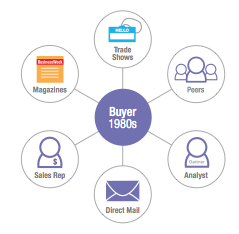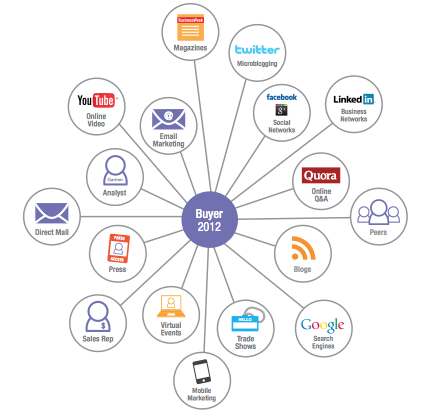Amazon.com and Business to Business Selling
Competing Against the Endless Aisle that is Amazon.com
Do you have a thought leader that you follow on a regular basis?
I have one that I consider a “stealth” thought guy. His name is Harry Joiner and he’s a recruiter for e-commerce professionals. Inside of his job posts I find some of the most thought provoking insights and today is no different.
Harry has posted a search for a Director of Woodwind and Brasswind for the Guitar Center.
Although it’s a Business to Consumer business with a strong bricks and mortar presence, they are effectively dealing with problems that all businesses are going to deal with. Especially my friends in the professional services industry. Bear with me on this one.
When I left school, the extent of our online activity was a sketchy text party line that we hooked up to with the first Macintosh. In the last 20 years the business climate has changed but I swear that in these last 24 months I’ve seen more changes than ever. They’re fundamental changes in how we communicate and what our expectations are when making decisions. Harry sums it up nicely in his set up for what the Director or WWBW would be responsible for.
“HARRY’S COMMENTS: It is amazing how profound Amazon.com’s impact has been on the business models of the Internet Retailer Top 500. Just two years ago, many fine companies were slugging it out in head-to-head competition with Amazon and finding out the hard way how impossible it is to compete with …
- One click ordering;
- A state-of-the-art website that gets smarter about its users with every click;
- MAP pricing;
- Free shipping in the guise of Amazon Prime (incentivized by free streaming content);
- and an endless aisle.”
It’s his set up for a random conversation he had with a muckity muck in Amazon’s executive ranks. Read this evidence of STEM gone wild:
“Speaking of the endless aisle …
Several weeks ago I was interviewing a very senior executive from Amazon for a CEO search. I asked this executive to tell me a success story about his impact on product sourcing at Amazon. His response …
“Oh, we have robots for that.”
“Robots?” I asked.
“Yes, Amazon has special software that scours the Internet 24/ 7 looking for products for sale, and constantly reconciling those offers for what is currently on Amazon’s website. When the software finds something that is not for sale on Amazon.com, it will bounce back out to the World Wide Web to find 4 other suppliers of that product.”
“When the software has 5 suppliers total, it will crawl all 5 websites, inhaling the names, e-mail addresses, and phone numbers (if available) of the relevant parties who might list those products on Amazon.com. That spreadsheet is then automatically forwarded to our buyers who follow up with each of those companies.”
I have no idea if this is true, but I can believe it.“
Amazing, right? I have friends in a IR 200 company that spend their days doing that. . .yikes.
That’s happening all over. Purchasing Agents who used to get information from a few sources that approached them:

The Old Ways via Marketo
Are now getting their information by going out and finding it:

The New Way also via Marketo
Salespeople are watching their best business development processes erode. Or worse, they can’t see it happening because they have no insight into what’s happening in the industry. It starts with a “Huh, that new company chose company XYZ? Never heard of them,” and turns into, “WTF?!?” in a hurry.
So what does that mean? It’s time to break out the old SWOT analysis and segment your approach. Harry describes it best here:
Anyway, several years ago I handled my first search for Guitar Center’s MusiciansFriend brand (IR #44). At the time, I was working with a VP of Marketing named Bryan Della Santina, whom I asked during the project kickoff call “Who are your top three competitors?”
Bryan’s response was “Amazon and eBay. I can’t remember who’s third.”
He had reason to worry. I have been a drummer since I was 11 years old. After college, I played professionally for several years before getting a real job. Marketing gurus will tell you that these days, every consumer has one area of their life where they spend rich. My area is drums.
I have seventeen 22 inch ride cymbals in my basement. Paiste. Istanbul. Zildjian. Sabian. Plus little known brands like Pasha and Ottaviano. $5,000 worth of metal just laying there waiting for me to beat it with a stick. Six of my cymbals came from eBay. The others came from MaxwellDrums.com, a niche marketer of drums and cymbals geared towards the professional jazz player.
Steve Maxwell is a model of trust and credibility for guys like me. A former management consultant, Steve understands that the only way to compete in retail is to have an emotional bond with your customers; to love the product and the niche so much that everything you do is essentially a labor of love. Everything this tiny little retailer does is a celebration of the artistry of jazz drumming. I could watch Steve’s content all day long. It’s almost like he runs a media company …
Is Steve worried about Amazon? Not at all. “Amazon is like a Coke machine. It’s convenient, but they’re not going to make anyone feel special. I’m not building a personal relationship when I buy from them.” Ebay is another story, but I have seen Steve buy foolishly priced drum sets on ebay and relist them on his site.
What does this have to do with WWBW’s search for a new GM? Lots!
Whatever Steve tells me to buy, I buy. If he gets a 22” pie that he knows I’ll love, he’ll send me a text and hold it for me until I respond. If I have a question about the diameter, age, origin, weight, or make of a cymbal on a particular record (like Pot Luck by Wynton Kelly), Steve will know. And so will his employees, who are excellent players in their own right.
I’ve learned to trust their judgment, and they’ve never abused that privilege.
That’s pretty much the direction music retail is headed in. The only thing more information intensive than a musical instrument is the relationship a player has with that instrument. It’s an intensely personal thing, and only a trained educator or merchant who knows both the player and the instrument is qualified to provide the player with informed and unbiased advice as to which instrument to buy.
The relationship between players and educators begins early.
Most musicians get their start in grade school or high school. According to First Research, there are more than 130,000 K-12 schools in the United States. Aside from a brief scare in 2008 when music programs and arts education were threatened with cuts, the future of public arts education looks very promising. In fact, there is growing sentiment in Washington around having more humanities in schools and teaching creativity rather than technical expertise.
WWBW has been selling to the K-12 market since 1978.
At one point, the business generated more than $90 million in sales, although the brand has seen a decline in the last couple of years. The brand was acquired out of bankruptcy by Guitar Center in 2007, and GC’s management has engaged top-flight business leaders to revive the brand.
Management seeks to return WWBW to what made it compelling in the first place: Deep knowledge of the category; knowledge of the key influencers; and a sales model that focuses on relationship driven selling as opposed to leveraged buying power and logistics (a la Amazon).
So that’s how it is, eh? Early in the sales cycle. Deep knowledge of the space. Influencing the key influencers. Relationship based selling.
I’m sure McKinsey has a quadrant graph for this and there’s some low value space where this isn’t happening or no one cares, but in the middle market where established businesses have worked their process and magic for many years, it’s time to take a look at the next few years and take steps to move in this direction.
CPAs, Lawyers, Engineers, Architects, Construction, Banking. . .the list of people who are dancing around this subject is impressive. It’s not an “online” problem or an “offline” problem that needs to be solved. It’s a fundamental process involving how we communicate now and how we’ll communicate in the near future, the jobs we do now and what things we’ll be automating in the near future.
“Time and tide wait for no man”. Let’s get to work.
Good stuff.
About the Author: Greg Chambers is Chambers Pivot Industries. Get more business development ideas from Greg on Twitter.

